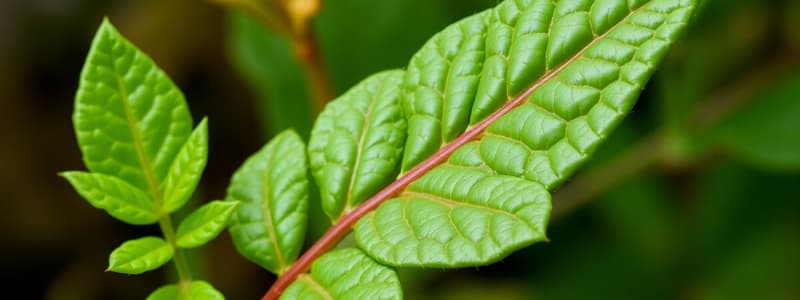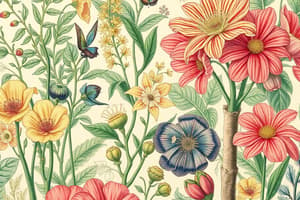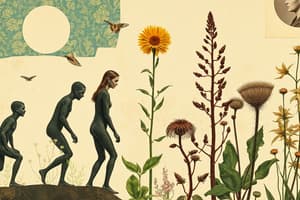Podcast
Questions and Answers
What significant development allowed vascular plants to grow taller and dominate terrestrial ecosystems?
What significant development allowed vascular plants to grow taller and dominate terrestrial ecosystems?
- The evolution of vascular tissue (correct)
- The ability to produce seeds
- The formation of complex leaves
- The development of thick bark
What reproductive strategy do ferns primarily utilize?
What reproductive strategy do ferns primarily utilize?
- Asexual reproduction through cloning
- Production of seeds for fertilization
- Budding from the parent plant
- Production of spores that are haploid (correct)
How did early nonvascular plants affect terrestrial ecosystems?
How did early nonvascular plants affect terrestrial ecosystems?
- They provided nesting areas for birds
- They created ecological niches for other organisms (correct)
- They reduced soil erosion significantly
- They generated food for arthropods
Why were early land animals like arthropods unable to colonize diverse habitats immediately?
Why were early land animals like arthropods unable to colonize diverse habitats immediately?
What impact did the spread of vascular plants have on the atmosphere during their proliferation?
What impact did the spread of vascular plants have on the atmosphere during their proliferation?
What characteristic distinguishes gymnosperms from other plant groups?
What characteristic distinguishes gymnosperms from other plant groups?
What type of structures did early vascular plant Psilophyton lack, despite having vascular tissue?
What type of structures did early vascular plant Psilophyton lack, despite having vascular tissue?
In the life cycle of plants, what structure develops after fertilization?
In the life cycle of plants, what structure develops after fertilization?
What are the two main types of yeasts used in brewing?
What are the two main types of yeasts used in brewing?
Which structures in true plants primarily facilitate the uptake of water?
Which structures in true plants primarily facilitate the uptake of water?
Which of the following groups includes flowering plants?
Which of the following groups includes flowering plants?
What is the process called that involves the alternation of generations in plants?
What is the process called that involves the alternation of generations in plants?
What is the role of phloem in vascular tissues?
What is the role of phloem in vascular tissues?
Which algae group is considered a precursor to land plants?
Which algae group is considered a precursor to land plants?
Which adaptation in plants helps to reduce water loss?
Which adaptation in plants helps to reduce water loss?
What is the primary function of xylem tissue?
What is the primary function of xylem tissue?
What defines a seed in seed plants?
What defines a seed in seed plants?
Which group of plants is characterized by having seeds enclosed in fruits?
Which group of plants is characterized by having seeds enclosed in fruits?
Why are grasses ecologically important?
Why are grasses ecologically important?
What does the term 'gymnosperm' translate to?
What does the term 'gymnosperm' translate to?
Which of the following is a common feature of all animals?
Which of the following is a common feature of all animals?
How do monocots differ from dicots in terms of their leaf structure?
How do monocots differ from dicots in terms of their leaf structure?
What does the diversity of gymnosperms include?
What does the diversity of gymnosperms include?
Which group of organisms is believed to share a common ancestor with animals?
Which group of organisms is believed to share a common ancestor with animals?
Flashcards
Nonvascular plants
Nonvascular plants
Plants without complex vascular systems for transporting water and nutrients.
Vascular plants
Vascular plants
Plants with specialized tissues (xylem and phloem) to transport water and nutrients efficiently.
Sporophyte
Sporophyte
The diploid (2N) phase of a plant life cycle, producing spores.
Gametophyte
Gametophyte
Signup and view all the flashcards
Meiosis
Meiosis
Signup and view all the flashcards
Fertilization
Fertilization
Signup and view all the flashcards
Spores
Spores
Signup and view all the flashcards
Vascular Tissue
Vascular Tissue
Signup and view all the flashcards
Yeast Fermentation
Yeast Fermentation
Signup and view all the flashcards
Domesticated Yeast
Domesticated Yeast
Signup and view all the flashcards
Ale vs. Lager Yeast
Ale vs. Lager Yeast
Signup and view all the flashcards
Green Algae
Green Algae
Signup and view all the flashcards
Charophytes
Charophytes
Signup and view all the flashcards
Plant Adaptations to Land
Plant Adaptations to Land
Signup and view all the flashcards
Xylem
Xylem
Signup and view all the flashcards
Phloem
Phloem
Signup and view all the flashcards
Seedless Vascular Plants
Seedless Vascular Plants
Signup and view all the flashcards
Seed Plants
Seed Plants
Signup and view all the flashcards
Gymnosperms
Gymnosperms
Signup and view all the flashcards
Angiosperms
Angiosperms
Signup and view all the flashcards
Monocots
Monocots
Signup and view all the flashcards
Eudicots
Eudicots
Signup and view all the flashcards
Grasses
Grasses
Signup and view all the flashcards
Animals
Animals
Signup and view all the flashcards
Study Notes
Diversity of Life
- The study of life's diversity is covered in Bio 2e, Chapters 21-29, and optionally Freeman Chapters 26-33.
- The hierarchical classification system of life includes domains, kingdoms, phyla, classes, orders, families, genera, and species.
Learning Goals
- Students will learn the major branches of the tree of life.
- Students will be able to name attributes of major animal phyla and plant divisions (e.g. invertebrates, vertebrates, plant divisions).
- Students will identify key groups of non-animal eukaryotes.
- Students will identify some major features of the groupings on the tree of life.
Relative Numbers of Named Species
- A pie chart illustrates the relative proportions of named species of various groups in the biological world, such as insects (beetles, flies, wasps, butterflies & moths with higher representation compared to vertebrates and fungi).
- Plants/Algae account for 18% of named species.
- Beetles represent 22% of the named species.
- Other significant groups include other invertebrates (12%), other insects (13%), fungi (4%), and other organisms (6%).
- Vertebrates account for 1% of named species.
Tree of Life/Phylogenetic Tree/Taxonomic Groups
- Three domains (Bacteria, Archaea, Eukarya) are shown on the tree, and they are derived from a common ancestor.
- Eukaryotes like animals, plants and fungi are in the domain Eukarya.
- Bacteria and Archaea are prokaryotes.
- This visual aids understanding the relationships of various organisms and their common ancestor.
LUCA
- Last Universal Common Ancestor (LUCA) was not the first form of life, but rather a survivor lineage.
- Various forms of life went extinct early on.
Prokaryotes
- Prokaryotes are the most abundant, ancient, and diverse organisms.
- They are characterized by the absence of a nucleus and membrane-bound organelles (no nucleus).
- This category includes bacteria and archaea.
Bacteria
- Proteobacteria, cyanobacteria, Gram-positive bacteria, chlamydias, and spirochetes are major groups of bacteria.
Proteobacteria
- Proteobacteria are a diverse group of bacteria.
- They include photoautotrophs, chemoautotrophs, and heterotrophs.
- There's no taxonomic distinction between "good" bacteria (essential to the biosphere) and "bad" bacteria (harmful to humans).
- Pathogenic bacteria exist within many different proteobacteria groups.
- Proteobacteria include the ancestors of mitochondria.
- Include Rhizobium species living in plant roots, and rickettsias (small pathogens living within animal cells).
Spirochetes
- Spirochetes are distinctive bacteria.
- They move via spiraling corkscrew motion.
- They can be free-living or parasitic.
- Syphilis and Lyme disease are caused by spirochetes.
Bacterial Photosynthesis
- Photosynthesis has evolved repeatedly in bacteria.
- Cyanobacteria are the best-known.
- Photosynthetic groups also include purple sulfur bacteria, green sulfur bacteria, and heliobacteria.
- Some groups use molecules other than water as electron donors.
- An example includes H2S oxidation by purple sulfur bacteria to form S granules (sulfur).
Archaea
- Archaea, although little known, are abundant and important organisms on Earth, found in habitats ranging from ordinary environments to extreme conditions.
- They are ancient organisms.
- This group includes methanogens, extreme thermophiles, and extreme halophiles.
- Unlike bacteria, archaea often have introns in their genetic sequences.
- Also similar to Eukarya, archaea have histones – proteins that compact DNA strands, unlike either Bacteria or Eukarya who frequently use different approaches to storing and using DNA..
Eukaryotes
- Eukaryotes—organisms with nuclei and nearly always with membrane-bound organelles—are a single branch on the tree of life.
- Modern studies suggest there are likely 11–20 kingdoms, including formerly classified "protists" like diplomonads and parabasalids.
Endosymbiosis
- Mitochondria and chloroplasts likely originated as symbiotic bacteria.
- The theory proposes that a prokaryotic cell engulfed another, forming a mutually beneficial relationship.
- Evidences are the double membranes, DNA, ribosomes similar to prokaryotes (in mitochondria and chloroplasts).
Viruses
- Whether or not a virus is "alive" depends on the definition of "life".
- Most viruses contain DNA or RNA.
- Viruses hijack host cells' transcription and translation mechanisms to make more viruses.
- Viruses lack metabolism and an independent energy source; they depend on a host cell for living processes.
Protists
- Protists are mostly unicellular eukaryotes.
- There are many different groups of protists, now recognized as separate "kingdoms."
- Some groups have acquired photosynthesis independently, becoming "algae," while others have evolved multicellularity.
- Some form multicellular associations, like algae.
Euglenozoa
- This is a large and significant group of flagellate protists.
- Branching off early in the eukaryote evolutionary tree, many are free-living while others are parasites.
- Some are photosynthetic mixotrophs, like Euglena.
- One important example is Trypanosoma brucei, the cause of African sleeping sickness.
Alveolates
- This eukaryotic clade has sac-like membrane structures and similar DNA sequences.
- Examples include ciliates, sporozoans, and dinoflagellates.
Ciliates
- A group of unicellular eukaryotes that move using cilia.
- Cilia are often used for feeding.
- They have both a micronucleus (for reproduction) and a macronucleus (for gene regulation).
- Many ciliates are free living, while some are parasites or commensals.
Dinoflagellates
- Dinoflagellates are important primary producers, especially in marine environments.
- They are characterized by a distinctive arrangement of two flagella, allowing them to move.
- Most dinoflagellates are mixotrophic, combining photosynthesis with prey ingestion.
- They are known for producing potent toxins.
Malaria
- Plasmodium is a genus of parasitic protists that causes malaria and infects birds, reptiles, and mammals (including humans).
- A dipteran (insect) vector (e.g. mosquito) is required for its life cycle.
- There are rounds of asexual reproduction in the vertebrate host inside red blood cells.
- Plasmodium is part of the Apicomplexa—an Alveolate group.
Malaria Life Cycle
- The malaria parasite has a complex life cycle, primarily involving mosquitoes and humans.
- Mosquitoes ingest gametocytes from human blood.
- Sporozoites develop from the zygote.
- Sporozoites migrate to the mosquito's salivary glands.
- When a mosquito bites a human, sporozoites are transferred to the bloodstream, followed by liver infection, and then red blood cells.
Plants
- There are 10 extant plants phyla.
- Some are nonvascular (e.g. mosses, liverworts, hornworts) while others are mosses.
Nonvascular Plants
- Nonvascular plants first appeared sometime in the Silurian period, around 440 million years ago.
Vascular Plants
- Plants with vascular tissue (xylem and phloem) evolved somewhat later (than nonvascular plants)
- Early vascular plants like Rhynia and Psilophyton were limited to wet areas.
Plants Adaptations to Land
- Roots absorb water and minerals from the soil.
- Leaves use photosynthesis to produce sugars.
- Vascular tissue carries substances between roots and leaves.
Plants Alternate Generations
- Plants have a life cycle that involves two alternating phases: sporophyte and gametophyte stages, with each having distinct ploidy (chromosome number)
- Sporophyte is diploid (2n), producing spores (n) through meiosis.
- Spores develop into gametophytes (n), which produce gametes (n) via mitosis.
- Fusion of gametes forms a zygote (2n), leading to sporophyte development.
Ferns
- Ferns are seedless vascular plants with diverse species (over 12,000).
- They have vascular tissue and produce spores for reproduction which are haploid.
- Dominant life cycle stage is the sporophyte.
- Mostly tropical and some temperate climates.
Seed Plants
- Seeds contain embryos and nutrients, with a protective coat.
- They are a crucial group in terrestrial ecosystems.
Gymnosperms
- Gymnosperms are a group of naked-seed plants where seeds are not enclosed in fruit.
- Conifers (pine, fir, spruce) are a diverse group.
- Gymnosperms include cone-bearing trees.
Angiosperms
- Angiosperms are flowering plants, with the most ecologically dominant group in terrestrial environments today
- Seeds are enclosed within fruits.
- Includes monocots and eudicots.
Monocots vs. Dicots (Eudicots)
- Distinguishing features based on structure of parts like roots, stems, leaves, and flowers.
Grasses
- Grasses (family Poaceae) are an important group of monocots.
- Widespread at the end of the Cretaceous period.
- Replaced ferns as the most important early-successional plants in many areas.
Animals
- Animals are multicellular organisms with homologous cell lineages descended from a single ancestor.
- Share a common ancestor with choanoflagellates, fungi, etc, forming a clade called opistokonts.
- About 35 major animal phyla have been identified.
Choanoflagellates
- Choanoflagellates are a group of single-celled protists.
- Morphology very similar to the supposed common ancestor of animals.
Sponges (Porifera)
- They are basal animals.
- Lack true tissues and organs.
- Have a body structure of a gel-like mesohyl between 2 layers of cells.
- Filter feeders with flagellated collar cells for creating water currents.
- Have regenerative capabilities. Spicules offer support but are not always present.
The Cambrian Explosion
- A period of rapid diversification of animal life around 530 million years ago.
- Most major animal phyla appeared in this period.
- Includes many extinct animal groups.
The Ediacaran Fauna
- Ediacaran fauna consisted of a diverse group of organisms that resemble animals (precursors of modern animals).
- The appearance of these forms around 600 million years ago reflects the Earth's recovery from massive glaciations.
- Characterized by unique physical structures, suggesting probable associations with microbial mats.
Ctenophores
- Ctenophores, also called comb jellies, are a group of animals.
- Morphologically similar to cnidarians in some ways.
- Thought to be an outgroup to other animals like sponges.
- They move via cilia.
Studying That Suits You
Use AI to generate personalized quizzes and flashcards to suit your learning preferences.




